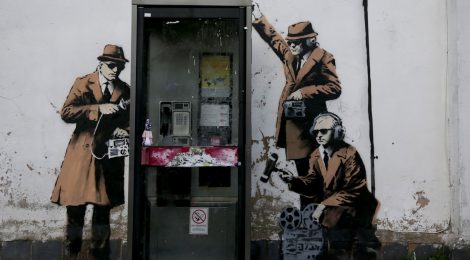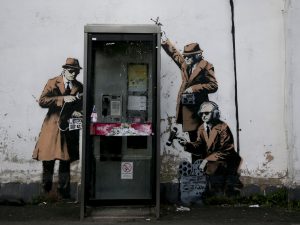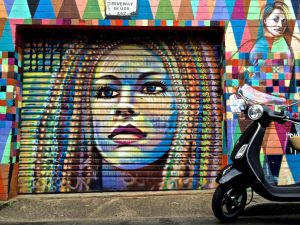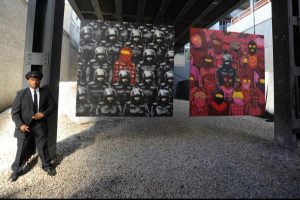
Graffiti: Art’s Brush with the Law

Graffiti artist Banksy’s “Spy Booth.”
On August 21, 2016, fear arose that the Banksy mural titled “Spy Booth,” was destroyed in Cheltenham UK. The mural, depicting three spies spying on a phone booth, has been defaced before, but now it can no longer be found at its location on the corner of Fairview Road and Hewlett Road (just three miles from GCHQ, a government listening post). In 2015, the Cheltenham Borough Council gave the critical mural protected status in an attempt to keep it from harm. The leader of the council, Steve Jordan, unaware that the mural was missing stated, “I will have a look at what the situation is, certainly.” Even the Gloucestershire police have been contacted to make sure that the mural is alright. It’s amazing—there is so much concern for this piece, but it’s really just graffiti on the wall of a house. Does this mean that despite its cultural taboo, graffiti is art?
In the Western world, “graffiti” is illegal and discouraged due to its encroachment on the Western concept of property. As graffiti artists tend to use walls and items that do not “belong” to them to scribble, scratch, or paint on, their “pieces” tend to be removed and the artists, if caught, placed into jail. This tends to lead to the idea that graffiti is not art and that it is the product of malcontents. However, its illicit nature does not mean that graffiti cannot be art or that it should necessarily be discouraged. As mentioned, property is a Western concept, defined by philosophers such as John Locke, Adam Smith, Thomas Hobbes, etc. On the other hand, other cultures and even other Western philosophies can sometimes see “property” as collective of the public. For example, the Cherokee Nation’s first article of law states, “The lands within the sovereign limits of the Cherokee Nation, as defined by treaties, are, and shall be, the common property of the Nation. The improvements made thereon and in the possession of the citizens of the Nation, are the exclusive and indefeasible property of the citizens respectively who made, or may rightfully be in possession of them.” [1] This concept, that everything belongs to the public besides what a person works upon or for, is not novel either. John Locke, a Western philosopher, wrote in The Second Treatise of Government that, “Whatsoever then he removes out of the State that Nature hath provided, and left it in, he hath mixed his Labour with, and joined to it something that is his own, and thereby makes it his Property. It being by him removed from the common state nature placed it, it hath by his labour something annexed to it, that excludes the common right of other Men.” [2] For John Locke, in order to own something, you must work upon it (just like with the Cherokee Nation). Despite its cultural taboo, “graffiti” is work upon a surface, and should not be disregarded as an art form due its illicit nature as defamation of the Western concept of property.

A photo of the May Lane Project.
Furthermore, graffiti does not necessarily have to be illegal, therefore deserving of more credit as an art form. Cameron McAuliffe, a professor at the University of Western Sydney, argues that graffiti can be described as a style of art, if not synonymous with “street art.”[3] Both “street art” and graffiti are typically done illegally and by members within the graffiti culture. The only differentiations that McAuliffe foresees is that graffiti tends to focus more on stylized writing and as a form of private communication among graffiti writers. He argues that both are appropriating public space in order to make a creative city and obtain a recognition—even notoriety—that cannot be achieved through traditional artistic methods. He defends this argument by discussing the city of Sydney which had the 2002 Parramatta Graffiti Management Plan. In this plan, the city built strips of walls around the city in public areas that were legal to be graffitied. Sydney also had the May Lane project, where any exterior walls in the area of May Lane were legal to graffiti. Hence, if there were legal graffiting areas, graffiti can not be inherently illegal. This also means graffiti must be a style or type of art that the city desired. Moreover, for McAuliffe, graffiti is art moved out of the gallery and into the public sphere, appealing to a larger audience. By deeming graffiti as illegal and non-artistic, cities are moving a step backwards and chaining art or “creativity” exclusively back into the art gallery. For him, if it is creative, it can be art and deserves to be visible.[3]
Yet, McAuliffe’s discussion of graffiti delves further into the discussion of what graffiti is and why it is art. One of the most common perceptions of graffiti is that graffiti is usually the name of the person who spraypainted the property in a one-color paint, plain, “non-artistic” fashion. McAuliffe calls these boring and non-artistic spraypaint jobs as “tagging.” McAuliffe cites statistics from residents of Sydney. The city council found that 91% of residents “distinguish a difference between ‘tagging,’ which was seen as a negative, [as opposed to] ‘graffiti’ and ‘street art.’” [3] Tagging is negative because it’s usually just writing a name, and therefore not creative and non-artistic. Even to those in the graffiti culture, boring tags can be called “throw-ups” and are discouraged for their lack of artistic value. Unbeknownst to most in the general public, graffiti artists tend to abide by certain, usually unspoken rules. One rule is that religious, historical, and other art “pieces” should not be graffitied. Small businesses, houses, cars, or other things owned by the working public are also off-limits. Another rule is that it is acceptable to cover up tags or throw-ups with artistic graffiti pieces. Evidently, the tags and throw-ups, especially on non-public property, significant places, or the property of the working class, are discouraged from the graffiti community as well. Renown graffiti artists do not intend to hurt members of society, but instead intend to spread “art” in a public sphere.
McAuliffe’s argument that creativity defines art is one that cultural critic Lewis Hyde supports as well. In his book, The Gift, Hyde describes that art is like a gift.[4] Artists are gifted talent, which takes the form of creativity. Without creativity, Hyde states that “art” would be boring and repetitive. Art is also a gift in that while art has a price, the experience of the art is a gift that is not affected by price.[4] Graffiti definitely complies with this. While the works of Banksy can have a price attached to them, Banksy only became popular due to the meanings of his work using the creative idea to montage conflicting images.

Banksy art protected by a security guard.
On the other hand, art philosopher Pierre Bourdieu believes that art must possess some sort of value and provide its creator some form of “capital.”[5] Though graffiti’s presence on walls and trains makes the idea of monetization seem almost impossible, graffiti can still be bought and sold, depending on the “social capital” (fame) of the artist. Despite the anonymity that tends to come with graffiti, graffiti artist’s tags are no different than a pen name that can possess its own sort of fame. In the case of Banksy, the public is frequently trying to capitalize on his work. Banksy’s art sometimes has its own security guards hired by landlords and random people from the public because people try to drill the paintings from the walls to sell them. Celebrities Brad Pitt and Angelina Jolie spent £1 million on just one of Banksy’s works; art pieces that sell for this price must have high profile artists with significant works. Just like other art forms, graffiti possesses a “capital” of its own.
Evidently, graffiti is a style of art regardless of its negative image for its typically illicit nature. It provides some sort of “capital” for its creators, embodies creativity, and provides an experience that is not affected by price. It allows for the general public to experience art outside and “unchained” from the gallery, even in legal forms. Hopefully, the respect for graffiti art will continue to improve as people are becoming more exposed to street art in all of its forms and the community that provides it.
_______________________________________________________________
- Laws of the Cherokee Nation. New York, NY: Legal Classics Library, 1995. Print.
- Locke, John, and Thomas Preston Peardon. The Second Treatise of Government. New York: Liberal Arts, 1952. Print.
- McAuliffe, Cameron. “Graffiti Or Street Art? Negotiating The Moral Geographies Of The Creative City.” Journal of Urban Affairs 34.2 (2012): 189-206. Web.
- Hyde, Lewis. The Gift: How the Creative Spirit Transforms the World. Edinburgh: Canongate, 2006. Print.
- Bourdieu, Pierre. The Rules of Art: Genesis and Structure of the Literary Field. Stanford, CA: Stanford UP, 1996. Print.
Comments are closed, but trackbacks and pingbacks are open.